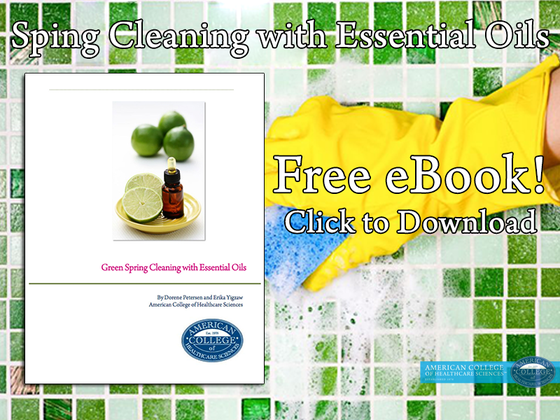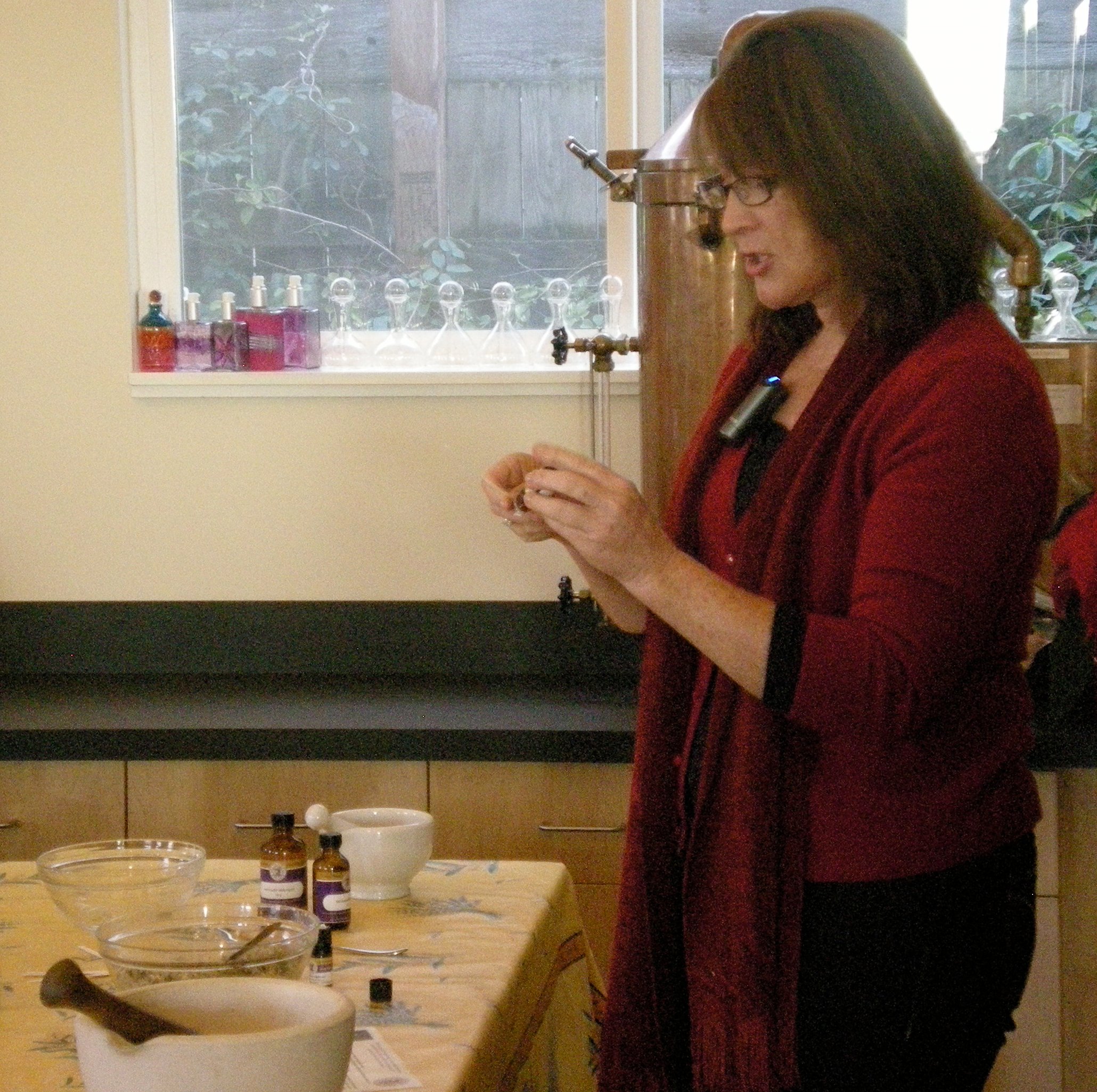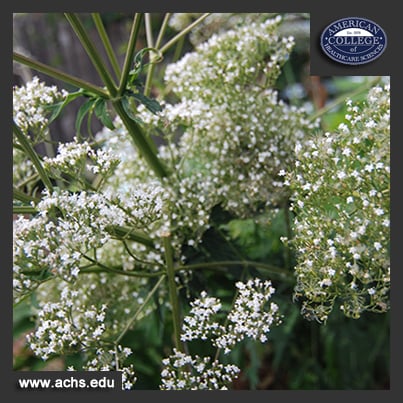Growing up the daughter of a naturopath in New Zealand, my sister and I were taught that the health of our planet is an important factor in the health of our bodies. It is pretty much common sense: A thriving environment directly impacts the health of humans (and our animal friends!). And it’s not just us, but our kids that will benefit from our green efforts. We have lots of kids between us in the ACHS team, and with a 12-year-old and my twins now nine months old, we want to make sure we’re doing everything we can to keep the earth green for them to enjoy.
That’s why we take “going green” pretty seriously at ACHS. When designing our new campus, we partnered with Energy Trust of Oregon to make sure we implemented sustainable and environmentally focused practices to reduce energy wherever possible, including energy reducing features in ventilation and heating systems, mechanical and electrical system operation, and lighting design.
We use energy efficient Dyson hand dryers in all the restrooms, and every room features automatic light sensors. Even the fabric in our cubicle workspaces is made of recycled polyester. Nearly everything was designed to reduce our carbon footprint.
I was thrilled when ACHS was named number 12 out of 100 Best Green Workplaces in Oregon by Oregon Business magazine this year. I’m proud to be part of a team that values our planet’s health as much as I do, and next year, we’re going for number one!
I’ll write up a separate post on the full list of things we did, but it started a few years ago with a couple of us setting up our Sustainability Committee around a small composting bucket and a reusable water filter!
So in the spirit of supporting a healthy earth, why not integrate a few green practices at your home and/or workplace? If you’re not sure how to get started, I have put together a few simple tips that can help “green” your life with minimal effort. Your planet (and your health!) will thank you for it! And maybe your workplace can make the Top 100 list next year!
Reduce Paper Waste
Did you know that an individual office worker uses approximately 10,000 sheets of copy paper per year? And did you know that reducing paper waste not only helps preserve valuable oxygen-producing forests, but it also reduces solid waste in landfills, saves energy, and reduces greenhouse gases emitted into the atmosphere?[1]
I know that paper is essential for most of us, but there are simple ways to reduce the amount you use at work and at home:
1. Create Recycled Notepads
Most of us already print double sided and re-use scrap paper for note taking. But have you ever tried to create little notebooks out of old check stubs?
Our Business Office Manager Suzanne Kent noticed that check stubs were the perfect size for homemade notepads. If they don’t contain sensitive information, you can try saving your own check stubs and bind them with a staple, paper clip, rubber band, or twine. If you slice them in half, they’re the perfect green replacement for index cards.
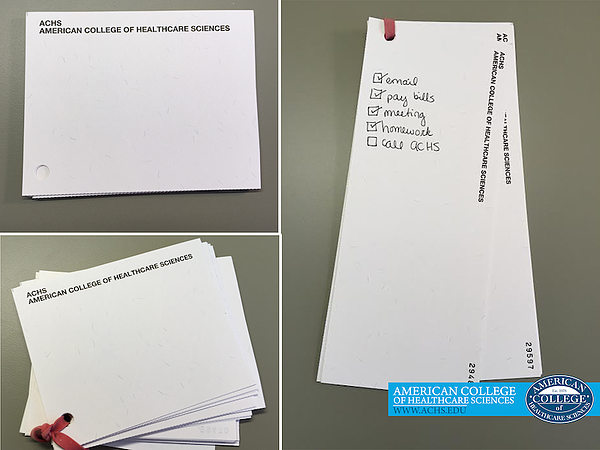
2. Use Hand Towels or Dryers
Almost 3,000 tons of paper towel waste is produced daily in the U.S. alone. As they decompose, paper towels emit methane gas, a leading cause of global warming.[2]
While wiping your hands on your pants is acceptable in kindergarten, it tends to be frowned upon even in Portland workplaces, so we’re in love with our Dyson Airblade hand dryers we installed at ACHS.
If your workplace is still using paper towels, consider bringing in your own hand towel. You can go even greener by repurposing an old t-shirt (sewing together the insignia portion of old t-shirts is a great way to save the bit you really liked anyway!). Or, if you’re interested in something that will dry quickly, People Towels are a great option: https://www.peopletowels.com/. They’re eco friendly and made with Certified Organic and fair trade cotton.
Reduce Chemical Use and Exposure
1. Clean Green with Essential Oils
If you follow our blog, you already know I’m a BIG fan of green cleaning with essential oils. Many conventional cleaning products contain Volatile Organic Compounds (VOCs), which not only pollute the air and degrade the ozone, but can also cause cancer, respiratory dysfunction, and many other scary health issues.[3] That’s enough reason to swap your chemical cleaners for homemade cleaning products made with essential oils.
Need help getting started? I have a whole blog post on this topic: Green Cleaning Swaps: How to Trade Toxic Cleaners for Natural Essential Oils in Your Home.
You can also look for a commercial green cleaning company in your area—you might be surprised that you can get green cleaning for the same price you’ve been paying the other guys and the intangible benefits of better air quality, fewer allergies, and saving the earth from some pollution are cherries on top!
2. Compost
Composting is a wonderful way to reduce food waste and nourish our farms and gardens at the same time. Not only does composting reduce waste, but it is much healthier for our planet than synthetic fertilizers. Unlike synthetic fertilizers, composting releases nutrients into the soil slowly—including micro and macronutrients, which are absent from synthetic fertilizers.[4]
Also, did you know that composting can reduce the need for chemical pesticides in your garden? When I used to volunteer as a Master Gardener, compost was my answer to about 90% of the questions I’d get! You probably wouldn’t be using nasty chemicals on your veggies anyway, but it’s nice to know that compost promotes microorganisms that can help fend off unwanted garden diseases and pests without you having to lift a finger.[5] I love my compost so much that the last two times I moved, I’ve actually moved my compost as well. Yes, I’m that crazy person that the mover guys talk about. And one of my “fun” weekend activities is turning my compost pile with my tractor bucket on the farm!
We have a wonderful composting program here in Portland, so it’s simple for us to collect compost here at the office staff kitchen in a small compost bucket with a charcoal filter, dump it into our big city delivered compost bin, and it gets whisked away to the city composting facility to be magically turned into gorgeous dark brown crumbly compost that smells more like forest floors rather than rotten orange peels.
But if you’re looking to start composting yourself, here’s a great step-by-step article: http://eartheasy.com/grow_compost.html. If you don’t have composting at your work, you can keep a large covered bowl in the freezer lined with a plastic bag and ask people to add their vegetable and fruit scraps to it. When it’s full, take it home and dump the whole frozen mess into your home compost heap. Or if you really want to go all Portlandia, save your food scraps for your chickens!
Save Our Most Valuable Resource: Water
1. Start a Vegetable and Herb Garden
As an organic lavender farmer and Master Gardener, I’m pretty sold on the idea of growing at least some of my own food or buying it from local sustainable farmers. The comfort of knowing exactly where my produce comes from and how it’s grown is a good thing.
But did you know that growing your own food is also better for the environment? Plants use photosynthesis to absorb carbon dioxide (a greenhouse gas) and produce oxygen. Eating homegrown food also means less gasoline is wasted to transport your produce to and from the grocery store. And your food will likely have higher levels of nutrients when it is picked and used fresh. If you don’t have much room, use some pots to start a small herb garden. I have some great YouTube videos on how to do that. It is super easy, and you’ll do a happy dance when you can bypass those $5 bunches of rosemary at the store and just pick it yourself from your own pot of herbs!
And, if you integrate the water-saving practices I’ve highlighted below, you’ll be saving one of our most precious resources: water.
2. Collect Rainwater: Try a Rain Barrel Water Collection System!
Yes, organic or sustainable gardening is great for the environment. But a healthy garden requires plenty of water. Save this natural resource and precious dollars by constructing a simple rain barrel water collection system.
Rain barrels are fairly simple to put together—a great weekend project. You can make one from a food safe plastic barrel or get really fancy like our wooden version here from Purple Portland Water. Check out Tiffany Stout, Apothecary Shoppe Production Lead, watering the ACHS Botanical Teaching Garden from our rain barrel water collection system.
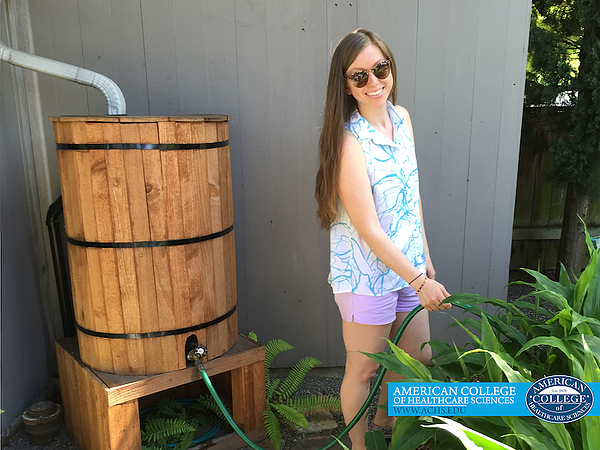
If you have room, you can install large rainwater tanks or cisterns. Back on Waiheke Island, where I’m from, we lived entirely on rainwater with 10,000 gallons of rainwater collection in two 5,000 gallon tanks. You’d think in Oregon that rainwater collection would be all the rage, but it has taken a few years (20 or so!) for the U.S. to catch up! Here in Oregon, July and August can be dryer than Arizona on average, so it makes sense to save up some of that liquid gold to use in the dry months. Plus, diverting rainwater out of the wastewater stream helps avoid fertilizer and other nasty run-off going into streams and rivers.
I’d like to install some rainwater collection tanks at my lavender farm in the next year or so. If your workplace has a garden or landscaping, suggest they install a rain barrel or three. They’re sure to appreciate your cost-saving initiative! There may also be tax credits or rebates available to help fund it! (Can you tell me if you find some?)
3. Collect Water from Your Shower
It gets pretty dry in the summer here in Portland, and the rain barrel can empty out quickly. Have you ever thought about how much water is wasted when you shower? If you have a spigot with a wide stream, some of that water may not even touch you! Yes, you can turn the water on and off (off while you condition your hair or shave your legs, for example).
Another way to save some water is called grey water collection and reuse. For example, taking a bucket or watering can into the shower with you to collect the excess water. Use eco-friendly shampoo and body soap, and when you water your non-edible garden you’ll be staving off aphids too! We also used to divert water from our washing machine (using minimal eco-friendly detergent, of course) for our non-edible gardens. Grey-water collection and reuse is illegal in some jurisdictions, so check with your county or city codes to see if you can do this. Why only on non-edible gardens? You wash your knickers in your washing machine and no one wants fecal coliform bacteria on their lettuce. Just saying.
To collect water for your vegetable or herb garden, wash your dishes in a container in your sink with eco-friendly dishwashing soap, let it cool, and then pour gently into the garden.
Are you going green this summer? Share your tips with me in the comments!
Disclosure of Material Connection: I am the CIO of American College of Healthcare Sciences, the Institution that publishes this blog. However, all opinions are my own. This blog may contain affiliate links. I am disclosing this in accordance with the Federal Trade Commission’s 16 CFR, Part 255: “Guides Concerning the Use of Endorsements and Testimonials in Advertising.”
This article is for informational purposes only. It is not intended to treat, diagnose, cure, or prevent disease. This article has not been reviewed by the FDA. Always consult with your primary care physician or naturopathic doctor before making any significant changes to your health and wellness routine.
[1] Stark State College. Fast Facts on Paper Use. Retrieved from http://www.starkstate.edu/green/paper-fast-facts
[2] Sarasota County. Greening Preschool. Greening Childcare. Retrieved from https://www.scgov.net/GreeningPreschool/Pages/PreschoolCleaning.aspx
[3] Environmental Protection Agency (2012). An Introduction to Indoor Air Quality: Volatile Organic Compounds (VOCs). Retrieved from http://www.epa.gov/iaq/voc.html#Health_Effects
[4] Washington State University, Whatcom County Extension. Compost Fundamentals. Retrieved from http://whatcom.wsu.edu/ag/compost/fundamentals/benefits_benefits.htm


